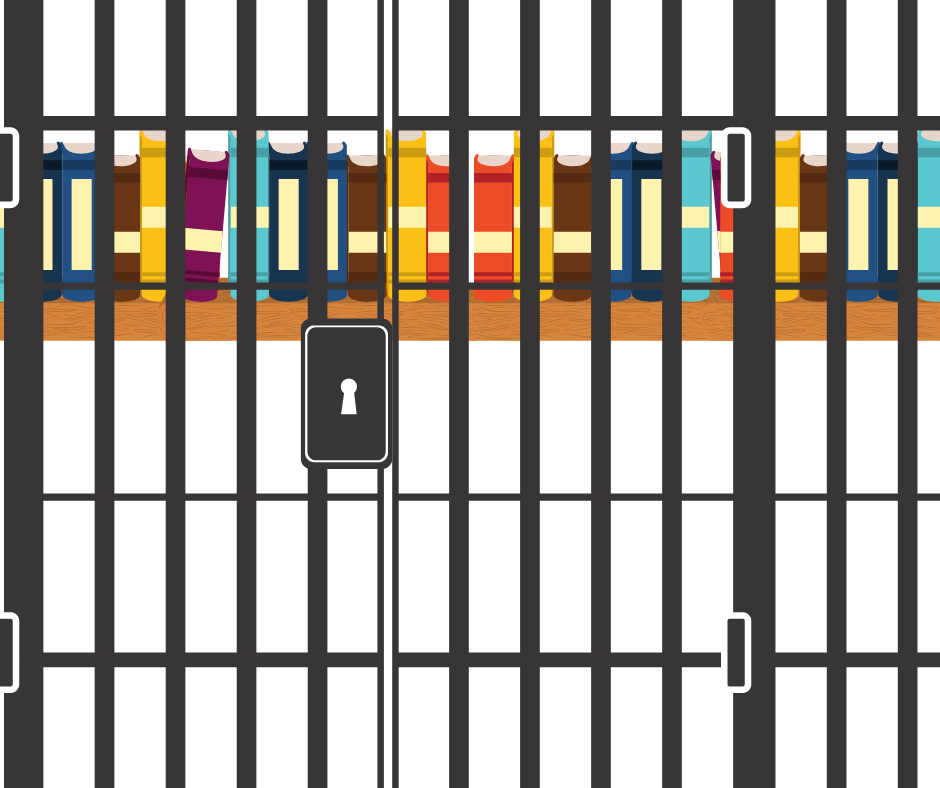
Banned Books Week starts this month, running from September 26–October 2. Each week leading up to the event, we will profile one of the many spaces in the United States where books are banned. We’ll look at who is banning and challenging, the type of material targeted, some of the issues faced, and links for more information and resources. In week one, we’d like to focus on prisons.
Who is Banning Books?
Prison officials control what books are allowed in the facility. The Federal Bureau of Prisons oversees Federal prison libraries, and state prisons are each handled by its respective department of corrections. Additionally, each state has a separate list of banned books. These booklists can contain as many as 20,000 titles. As PEN America has found, these restrictions are the largest banning of books in the US. Beyond department policy and the list of banned books, each prison may have additional policies in place and rely on administrative judgment calls. These restrictions often have little oversight or public scrutiny.
What Books and Why?
There are many reasons prisons ban books. The biggest concern is if they are considered a security issue. Two other main concerns are books containing sexually explicit or violent material. In response to these concerns, the bans are often arbitrary and over-broad. Material targeted includes subjects like social justice, prison reform, and how-to books, as well as nudity.
Comics are frequently targeted for violence and nudity. Manga, in particular, has been the target of the prison censors. Authorities view the nude pictures and character fashion in manga as either sexually explicit or pornographic.
Perhaps the most surprising of the books targeted are the how-to books. Presented as security issues, these bans target electronics, computer language, and drawing books. Instructional books like Stan Lee’s How to Draw Comics, How to Draw Comic Book Heroes and Villains, and How to Draw Nearly Everything are among those that are banned. These bans block the opportunity for an incarcerated person to learn how to create comics and build a lifelong skill!
Issues
The vagueness of the policies and inconsistency with which they’re applied poses the greatest issue. The heavy lifting of retaining or banning books from the prison is in the hands of individual prison officials. Bans depend on the whims and personal preferences of the individual in charge, which changes from facility to facility. Some officials, due to budget or time, find it easier to be over-broad. This issue can be seen in the treatment of nudity most acutely.
Many policies don’t allow pornography or sexually explicit material. There doesn’t seem to be a line drawn between those materials and nudity. Regarding manga, Diana Woodside, director of policy and legislative affairs for the Pennsylvania Department of Corrections, said, “[It] really has really vivid graphic pictures that include sex acts and nudity…Is it better to allow it in, or to not allow it? Does it really impact the atmosphere of the institution? I don’t know the answer to that…There’s a lot of inconsistencies. I would love to see a standard for nudity.”
Inconsistencies are also seen when comparing the material on TV versus in books. One prison in Alabama banned the book Slavery by Another Name; however, they allowed a showing of a PBS documentary based on the book. This inconsistency highlights the lack of attention and oversight to these bans.
The issue of budgets is also a limiting factor for access to books and graphic novels. Libraries tend to have small budgets and limited libraries. Folks who want to send books to their loved ones have to jump several hurdles. It is hard to tell if a book will be rejected due to its content or condition. Several organizations have been formed that provide reading material and send requested books to incarcerated individuals.
Resources and Further Reading
Articles
CBLDF Guide to Donating Comics
WA Reverses Prison Book Ban After Failed Defense
Manga Highlighted in Prison Censorship Discussion
Comics, Manga, Neil Gaiman, and More Banned in KS Prisons
Prison Book Bans Called ‘Arbitrary and Irrational’
ACLU Explains Banning Book Critical of Prisons Unconstitutional
Donation Programs
Books Through Bars
Books Through Bars has been sending free books to incarcerated people in six mid-Atlantic states (Pennsylvania, New York, New Jersey, Delaware, Maryland, and Virginia) for over 30 years.
Books to Prisoners
Books To Prisoners is a Seattle-based nonprofit organization whose mission is to foster a love of reading behind bars, encourage the pursuit of knowledge and self-empowerment, and break the cycle of recidivism. Books to Prisoners believe that books are tools for learning and for opening minds to new ideas and possibilities, and engage incarcerated individuals with the benefits of reading by mailing tens of thousands of free books to inmates across the country each year. In 2015, the City of Seattle recognized Books to Prisoners as a Human Rights Leader.
Prisoners Literature Project
The Prisoners Literature Project is an inclusive, all-volunteer, grassroots nonprofit whose purpose is to encourage reading, the pursuit of knowledge, and self-determination among incarcerated people. By sending free reading materials to those behind bars, PLP aims to foster learning and critical thinking. We believe that all people have a right to read.
Prison Book Program
Founded in 1972, Prison Book Program is a grassroots organization that exists for one purpose—to send free books
Books are crucial to the political, spiritual, and educational development of all people. Most prisons do not allow family and friends to send books into prisons. They must come from a bookstore, publisher, online retailer or a program like PBP. They serve over 10,000 prisoners each year.
Prison Book Network (Prison Book Program)
A state by state list of programs providing books to prisons. Also includes organizations serving Canada and England.